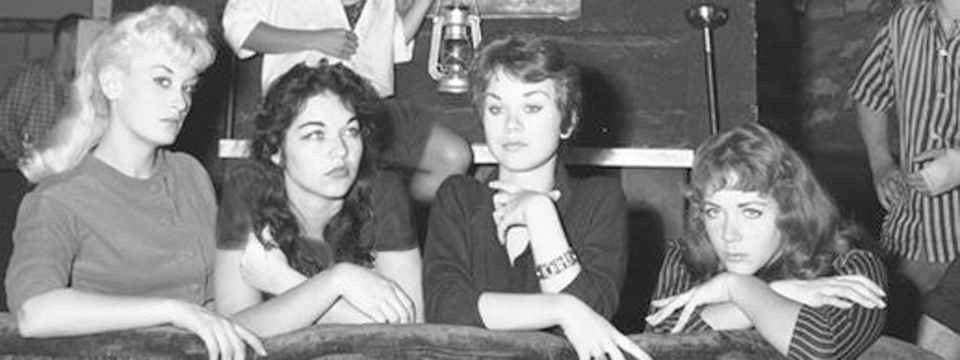
by Chris Forbes | Apr 8, 2013
Okay, we’re off to a start on our series of articles about the generations when they were 25. First up, the Silent Generation (born: 1925-1945) Age: 68-84.
If you are looking for cool people with a youthful outlook and a bent toward technology to talk with, why not sit down and talk to someone who’s in the Silent Generation? They invented most of the technology you use today! There were Silent Generation Beatniks swilling strong coffee long before there was such a thing as Starbucks. True, they didn’t have WIFI in their coffee shops–so they invented it…with their bare hands.
Silent? You keep using that word. I don’t think it means what you think it does.
In 1950 the oldest members of the Silent Generation turned 25. Nicknamed the Silent Generation by a 1951 Time magazine article that mistakenly portrayed them as less enthusiastic and significant than their parents and grandparents’ generation, the people that make up this generation are far from silent.
They were born in a very difficult time in the United States. On their birthdays (from 1925 through 1945) the country was either in desperate economic hard times or engaged in world war. Because times were tough, most families chose not to have children or perhaps could not because of war. Therefore the Silent Generation is the smallest generational cohort now ling in the United States. Oklahoma has 285,410* people in this generation.
In the 1950’s the Soviet Union launched the Sputnik satellite and the youthful Silent Generation members took it as a personal challenge to them. That event charged them with the energy that built the new economy of America—and inspired them to work toward a future without limits or rivals. Most of the corporations and organizations that form the present foundation for the American economy and infrastructure were formed during their lifetime.
Despite the hard times into which they were born, the Silent Generation is also known as the “Lucky Generation” because they were born just in time to get in on the ground floor of decades of unmatched historic economic prosperity in America.
Life in the SBC
Keeping pace with their Silent Generation tendency toward leadership, the SBC “Lucky Generation” built the institutions of the Southern Baptist Convention . Under their leadership, the SBC was grew faster than it has ever grown numerically, from about 7 million members in 1950 to 16 million in 1996—an increase of 128%. A list of Silent Generation leaders in the SBC would be a Who’s Who in SBC history.
What’s the Silent Generation Outlook?
Not to paint with too broad a brush, but the common experiences of the Silent Generation lend a large number of them to having a similar outlook on life and spirituality. If you are involved in ministry leadership with people aged 68-84, you are truly blessed. Strive to fully appreciate and mobilize this generation of leaders in your church.
Mass Revival-Oriented Spirituality: A common theme in Silent Generation spirituality is the emphasis on returning to God en masse and reviving the collective spiritual vitality. From their youth historians have noted they have had a particular sense of dedication to the Lord that was greater when compared to previous generations.
Personal Responsibility in Context to Others: The Silent Generation believes each person should make the appropriate sacrifices to see to it that the whole group experiences success. Their ethics of combined hard work and commitment to one another have made them successful in many ways.
Take Charge Leadership: Silent Generation people know how to follow leaders. They appreciate it when someone takes the reins of leadership, provided they do so with humility and respect toward others.
Manage the Money: The Silent Generation tends to be very frugal, they prefer to review expenditures as a group and hear the justification for each one from their leaders.
Technology: They remember when you could fix things with your own two hands and they knew how to do it themselves. This is the generation with the know-how that put a man on the moon using slide rules and a computer that had less memory and computing power than your cell phone…which they invented.
*stats courtesy of Oklahoma Direct

by Chris Forbes | Mar 25, 2013
Some time in the early ‘90s, a couple of techies in Silicon Valley were hanging out at a park when they caught a glimpse of a weasel scurrying by with a slice of wrapped American cheese. They knew in an instant it must be the Cheese Weasel delivering a piece of cheese to some good little techie. After all, someone must be showing all the good techie boys and girls some appreciation.
And so began the story that morphed into the urban myth of the Cheese Weasel who brings cheese to the good little tech industry workers. Each April 3rd the Cheese Weasel leaves a piece of cheese under their mouse pads.
Since that time, the celebration of the Cheese Weasel has grown and become an Internet holiday tradition that celebrates the contributions of workers in the tech industry. Tech workers get a lot of grief from people and are often under-appreciated. Cheese Weasel Day is a fun way to say thank you to them.
Over the years people have made art, music, prose and poetry to support and celebrate the myth of the Cheese Weasel. It’s all for fun and just to be nice to people who do a lot of good things for us.
I like to think of CWD as the milk of human kindness, curdled. As we all know, kindness is a fondue-mental human need.
So, what is your contribution to the Cheese Weasel Day fun going to be this April 3rd?
Here are a few ideas from the Cheese Weasel Day website:
- Give your favorite tech person a Thank You shout out using #cheeseweaselday on Twitter and Facebook
- Send someone you know in the tech sector a Cheese Weasel Day Greeting card from the evangelism website MostImportantThing.org. Here are their Cheese Weasel Day E-cards.
- Arrange secretly for a slice of cheese to be placed under the mouse pad of a tech person you know. [Check back in a few days to make sure they found the cheese. Just to be sanitary. I mean, if they don’t know about it and leave it there indefinitely, it could start to smell like Limburger.]
- Go here and learn the Cheese Weasel Song
- Plan a Cheese Weasel Day party. It’s fun! A fondue party, make grilled cheese sandwiches, nachos, or Cheetos on the house!
So, what is your contribution to the Cheese Weasel Day fun going to be this April 3rd?
“Therefore encourage one another and build each other up, just as in fact you are doing.” 1 Thessalonians 5:11

by Chris Forbes | Mar 12, 2013
Writing for WordSlingers has me feeling like a 25-year-old again. I haven’t felt that young since 1988, when I was 25.
Then, I did the math and realized that people who are now 25 were born in 1988. That then got me thinking about sinking into a box of Samoas Girl Scout cookies to drown my feeling of lost youth.
I have mission trip t-shirts that are twenty-five years old!
When I was 25 I had just quit trying to be a stand-up comedian in the amateur night comedy shows and decided I better get back to college (I graduated high school in 1982). While returning to university, I got involved in BCM (then BSU) and became very interested in mission trips and ministry. That was also the year I started praying about being “in the ministry.” But I used to struggle, why would God take me out of stand-up comedy and put me into the ministry? Then someone suggested, “Well, maybe He saw your act!”
That was a long time ago, but it feels like yesterday. What were you doing when you were 25? Maybe you’re 25 now. Aren’t we all really just a bunch of 25 year olds?
There are several generations of twenty-five year olds all around you. And if you care to, you can teach yourself to see the world through the young eyes of the older.
Speaking of missions, when missionaries begin working with people groups, they study and understand each group. Knowing who you are trying to reach is the starting place for good ministry. Every day in ministry you are serving people, so you should take it upon yourself to become an expert on them.
Presently, there are five generations of twenty-five year old people in the marketplace. Which one do you belong to?
- Silent Generation (born: 1925-1945) Age: 68-84. When they were 25: 1950
- Baby Boomers (born: 1946-1954) Age: 59-67. When they were 25: 1971
- Generation Jones: (born 1955-1964) Age: 49-58. When they were 25: 1980
- Generation-X (born: 1965-1979) Age: 34-48 When they were 25: 1990
- Millennial Generation (born: 1980-1996) Age: 17-33 When they were 25: 2005
These generations each have perspectives and needs that differ from each of the others. In the next few posts in this series, I will write about these generations of 25 year olds, what they are like now and suggests ideas to be successful in reaching them. I hope you will read along!

by Chris Forbes | Feb 20, 2013
There are a lot of interesting things going on lately [awkward pause to drink some water] …so lets get started!
I’m not trying to get political, but did you see the response to the State of the Union address? That guy really came out swinging!
Things are crazy in DC, we just found out the US Post Office is coming out with a line of clothing. It’s fashion for people who are always on the slow.
I can’t wait for other government offices to come out with their own clothing designs. Next year the Hollywood red carpet question will change from “Who are you wearing? to “Hey, that’s my stuff!”
Speaking of the government, Washington is launching an investigation into that cruise ship disaster. So glad nobody was hurt, but it looks like Congress wants to see what they can do. If anyone knows about sinking ships, it’s the folks in DC.
You really can sue a ham sandwich?
Two New Jersey men are suing Subway sandwich shops saying their famous footling subs are not actually 12 inches long. I’m not sure if these guys are trying to be Heroes, or just they just have an ax in the Grinder.
They may be disappointed when they learn that Burger King & Dairy Queen are not of noble birth and that Chuck E. Cheese doesn’t really have middle name.

by Chris Forbes | Feb 5, 2013
The Big Game 2013 is in the history books. You know what I mean by “Big Game,” right? Big Game is the only NFL approved way to refer to the Super Bowl XLVII (Oops) if you are not an official sponsor of the event. After being exposed to some of those commercials, maybe it’s best not to be mistaken for an official sponsor anyway.
Back to the game. It was a close one. And just to know that the head coaches of the opposing teams were brothers added even more to the drama. To me, it was also thought provoking to think that I could’ve been playing my brother in the Super Bowl…if only my brother was doing his part.
After halftime there was an electrical blackout at the…er…Big Game. Boy, that made the whole experience even more historic! So much so, I even stopped watching Downton Abbey for a few minutes just to see what was going on.
Somebody bungled our bundle!
Speaking of blackouts, our house lost all digital connectivity when our cable company went down recently. It was not just my house, people in 15 states lost all Internet, phone, and television. Rumor was the company was hacked, I’m not sure if that’s true, there’s a lot of hacking going on these days–but the customers sure were hacked.
The outage lasted for three days, to pass the time our family entertained ourselves by taking turns lip syncing the Star Spangled Banner.
Crazy for us too, that very week the microwave in our house went down. It was very rustic living with no TV, phone, Internet, …or Lean Cuisine.
I started making handmade furniture and cheese to sell to the tourists who wanted to see how we lived.
Photo by Ken Durden / Shutterstock.com.




